牛津英语8A_Unit4_Reading_Giant_pandas教案设计
- 格式:doc
- 大小:59.50 KB
- 文档页数:11
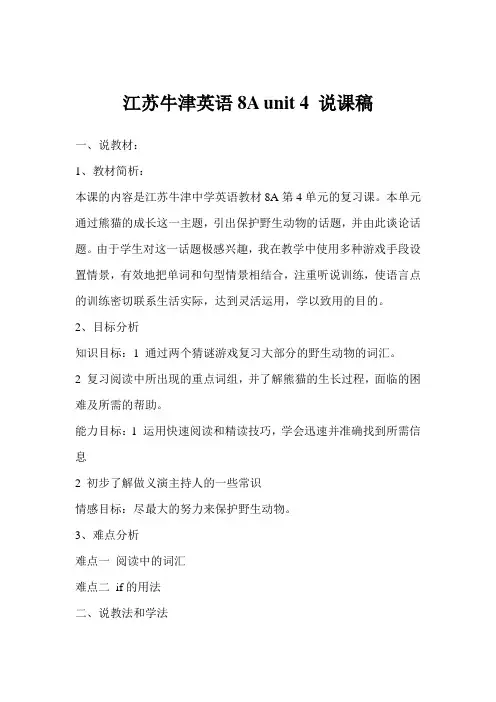
江苏牛津英语8A unit 4 说课稿一、说教材:1、教材简析:本课的内容是江苏牛津中学英语教材8A第4单元的复习课。
本单元通过熊猫的成长这一主题,引出保护野生动物的话题,并由此谈论话题。
由于学生对这一话题极感兴趣,我在教学中使用多种游戏手段设置情景,有效地把单词和句型情景相结合,注重听说训练,使语言点的训练密切联系生活实际,达到灵活运用,学以致用的目的。
2、目标分析知识目标:1 通过两个猜谜游戏复习大部分的野生动物的词汇。
2 复习阅读中所出现的重点词组,并了解熊猫的生长过程,面临的困难及所需的帮助。
能力目标:1 运用快速阅读和精读技巧,学会迅速并准确找到所需信息2 初步了解做义演主持人的一些常识情感目标:尽最大的努力来保护野生动物。
3、难点分析难点一阅读中的词汇难点二if的用法二、说教法和学法根据我对《英语课程标准》的理解和九年级学生的生理和心理特点,我将教学本课的指导思想确定为:让学生主体参与,主动探究,合作互动,充分发展。
具体采用如下教学方法:1、情景教学法:通过设置较为真实的情景,如视频、图片、动物世界的开头曲与片尾曲等,使学生产生身临其境的感觉,激起学生情感上的共鸣,从而引导学生从整体上理解和运用语言,促进学生的语言能力及情感、意志、想象力、创造力等整体发展。
2.任务型教学法:我设计了各种任务,通过感知、体验、参与和合作等活动方式,使学生的主体地位得到充分体现。
例如,要求学生阅读文章,完成填空等。
3、头脑风暴法:把大多课堂时间留给学生,使学生在多信息、高密度、快节奏的灵活操练中拓宽学习渠道。
三、说教学程序1、视频“动物世界”导入,采用直观法,引起学生共鸣,激发学生学习兴趣也为后面的教学做了一个提早渗透;2.然后采用了游戏法,第一个游戏把动物的图片遮掉一半,让学生猜,使学生首先在心理上感到放松,学生在轻松愉快的气氛中进入本课的学习,第二个游戏让学生把字母顺序混乱的单词重新排列,复习单词。
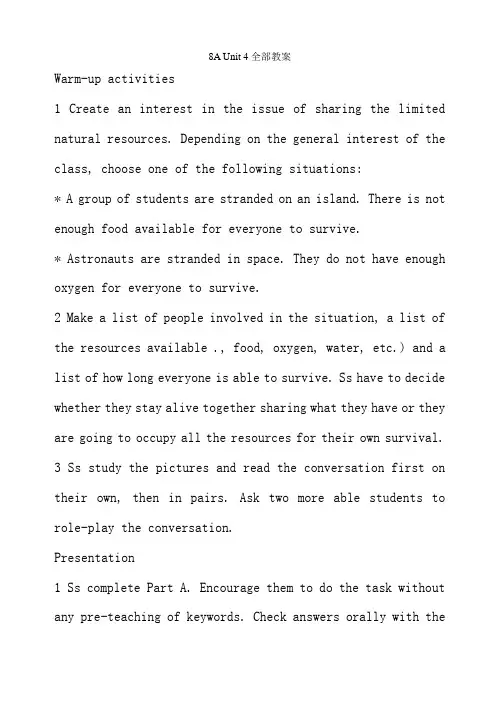
8A Unit 4全部教案Warm-up activities1 Create an interest in the issue of sharing the limited natural resources. Depending on the general interest of the class, choose one of the following situations:* A group of students are stranded on an island. There is not enough food available for everyone to survive.* Astronauts are stranded in space. They do not have enough oxygen for everyone to survive.2 Make a list of people involved in the situation, a list of the resources available ., food, oxygen, water, etc.) and a list of how long everyone is able to survive. Ss have to decide whether they stay alive together sharing what they have or they are going to occupy all the resources for their own survival.3 Ss study the pictures and read the conversation first on their own, then in pairs. Ask two more able students to role-play the conversation.Presentation1 Ss complete Part A. Encourage them to do the task without any pre-teaching of keywords. Check answers orally with thewhole class.2 Divide Ss into pairs and ask them to do the survey in Part B13 Encourage them to discuss in pairs why they like or do not like the animals. Ask them to write down their ideas. Language pointsLook delicious, If you eat my food, I won’t talk to you., no one, in danger, a report on giant pandasHomework1 Learn the language points by heart.2 一课三练3 Preview the Reading Part.?Revision1 Review key vocabulary according to the general ability of the class. Presentation (Reading A)1 On the Bb, write the following list of sentences on the Bb: * Xi Wang is the name of a baby giant panda.* Baby giant panda s are very small when they were born.* They grow very quickly.* Xi Wang has to find her own food when she is 20 months old. * Hunters kill giant pandas and sell their fur.2 Divide the class into three groups and allocate one part to each group. While students skim the text on their own, ask them to underline the words they do not know. Then go through the words students have underlined. Ask students to explain briefly how they know that the sentences on the Bb are true by identifying and listing key facts in the text. Presentation (Reading B& C)1 Ask Ss to draw a parallel between the growth of the baby giant panda and a human baby. Ask if they know what happens to people while they grow up. Write the following words/phrases on the Bb.Adult old person teenager baby middle-aged personYoung adult child toddlerDraw a timeline and encourage Ss to come forward and write each word at the correct point on the timeline. Ask them to drawa more creative growth chart.2 Ask students to do a birth chart of themselves. Tell them to add their photos to the chart.Presentation (Reading D)1 Revise the words listed in the box in Part D.2 Ask students to complete Part D. Then ask some Ss to read the sentences aloud to check their choice of words.3 If they show interest, ask them to practice the text for a presentation for 2-3 minutes.Presentation (Reading E)1 Ask Ss to read the conversation in Part E in pairs to check if there are any words they do not know. Then ask Ss to complete the sentences individually.2 Ask six Ss to read the conversation while the rest of the class check their answers.Language points (Part A)The story of Xi Wang, only 10 days old, it me ans…, was born, weigh just 100 grams, at four months, for the first time, eight months later, not…any more, grow into, at the very beginning, up to 14 hours a day, bamboo shoots, have to look after herself, have another baby, It is adj. (for sb.) to do, some of the problems, kill it for its fur, nowhere to live, on their own, need help, in danger, take the following actions to do, protectgiant pandas, make giant panda reserves bigger, encourage sb. to do, there will beLanguage points (Part B& C)Keep sb./sth. Safe from danger, large areas of land with trees, special areas for wild animals, stay aliveHomework1 Learn the language points by heart.2 一课三练3 Preview the Vocabulary Part.?Presentation (Vocabulary)1 Creat an interest in animals. Try to extend the context by asking Ss if they would like to adopt an animal and , if they do, which one they would choose.2Use the task to check Ss’ knowledge of name of animals. Ask Ss to guess the names individually first and then compare witha partner.3 Check answers with the whole class. Read all the words under the pictures and ask Ss to give definitions.Language pointsPolar bear---North Pole, wolf----wolvesHomework1 Learn the language points by heart.2 一课三练3 Preview the Grammar Part.?Presentation (Grammar Part A)1 Try to elicit the conditional structure by asking questions such as What will happen if you come to school lats What will happen if you break your favourite toy Try to think of sentences which reflect Ss’ own experience. Wr ite the most interesting answers on the Bb. Ask Ss to include the “If”-clause as well. Read all the sentences again and ask more able Ss to elicit the rule.2 Write some more open “If”-clauses on the Bb and ask Ss to finish the sentences with their own ideas. Help Ss reformulate their ideas into correct sentences and write them on the Bb.3 Ask Ss to match the sentences on their own and then compare answers with a partner. Invite a more able student to read the sentences aloud for the rest of the class to check answers.4 For Part A2, Ask Ss to complete the sentences on their own and then compare answers with a partner. Check answers with the whole class.5 Ask Ss to complete “Work out the rule” at the bottom of page 61.Presentation (Grammar Part B)1 Ask Ss to read through the rules and the sample sentences on their own. Then check understanding by asking them to think of other examples.2 Write several “If”-clauses on the Bb and ask more able Ss to complete them with their own ideas. Remind them to write about repeated and predictable situations instead of possible results.3 Explain the context of Part B1. Revise the words in the box.4 Ask students to complete the sentences individually.5 Ask Ss to read the conversation with a partner checking the accuracy of their sentences. Then check answers with the class.Presentation (Grammar Part B2)1 Try to creat interest in learning interesting things aboutwild animals. Tell them that Amy’s report introduces new information about tigers and wolves.2 Explain the context of writing a report. Revise the structure of conditional sentences.3 Ask Ss to read the report on their own to make sure that there are no unfamiliar words. Then Ss complete the sentences individually and compare them with a partner. Check answers with the whole class.Language pointsGrow more bamboo, run the other way, go to North Africa, walk through a rainforest, learn a lot about wild animals, arrive at noon, see the feeding of animals, get enough information for my class report, attack people, spit poison, step on them, male wolvesHomework1 Learn the language points by heart.2 一课三练3 Preview the Integrated skills Part.?Presentation (Integrated skills A)1 Invite students to talk about what they like about tigers and wolves. Brainstorm any information and general knowledge about the two animals.2 Ask Ss to study the two fact files in pairs. Check the meaning of some of the words.3 Help Ss focus on the general context by asking general questions they may be able to answer while listening for the first time. Write them on the Bb:* What is the name of the largest living cat* What is Millie’s favourite animalPlay the recording. Students listen carefully for keywords to answer the questions.4 Play the recording for again and ask students to find out the missing facts in the fact sheets. Play the tape for the third time for Ss to check the answers.5 Ask Ss to read the letter in pairs and discuss any words they do not understand. Complete the letter without looking at the fact sheetson page 64. Then ask them to look at the fact sheets to check the answers and make corrections if necessary.6 Ask more able Ss to read aloud the letter.Presentation (Integrated skills B)1 Ask students to practice the conversation in pairs and then change roles. Identify any words or phrases they do not know.2 Ask students to create their own conversation using information from the fact sheets.Language pointsLive as a family, good at hunting other animals, make medicine, friendly towards each other, loss of living areas, make medicine from their bones, buy clothes made of animal fur, look lovely on me, lose one’s life, someone else, Homework1 Learn the language points by heart.2 一课三练3 Preview the Pronunciation, Main task & Check out Part. ?Presentation (Pronunciation)1 Remind Ss of communicative purpose of conditional sentences.2 Play the recording for Part A and ask Ss to listen carefully.Ss imitating the rising and falling voice patterns.3 Ask students to read Simon’s pres entation with correct the rising and falling voices.4 Ask students to read Millie’s presentation in Part B quietly on their own. Play the recording . Ask Ss to listen carefully and mark where Millie’s voice rises and falls with the correct arrows.5 Tell students to read them again, and answer the ‘Wh-‘questions. Students work in pairs.Language points (Pronunciation)Peaceful animals, live in family groups, continue to build roads, have suitable homes, make new farmland, make a lot of money, sell eleph ants’ tusks, train them,Presentation(Main task)1 Talk to Ss about the purpose of writing reports. Elicit from the different reports. Explain that in reports, we do not normally say ‘I feel…’ or ‘I like…’ and do not include personal comments.2 Read the title of the report in Part A. Create an interest in the topic by asking what they have learnt about giant pandain this unit.3 Ask students to skim through the report quickly and give each paragraph.4 Ss complete Simon’s report in Part C on their own. A sk more able Ss to read it aloud to check the answers.Language points (Main task)Spend a lot of time drinking their mums’ milk, at a time, get smaller and smaller, become farmlands, keep taking the land, what action can the club take Sharp paws, walk upright Presentation (Checkout)1 Set a time limit for reading the sentences in Part A and for filling the blanks. Ask Ss to complete the task on their own.2 Ask students to Proceed to Part B after completing Part A.3 Ss complete Part B on their own and then compare answers in pairs.Language points (Checkout)Climbing, what about playing football, a friend like Alan, answer questions correctlyHomework1 Learn the language points by heart.2 一课三练3 Preview the Unit 5。
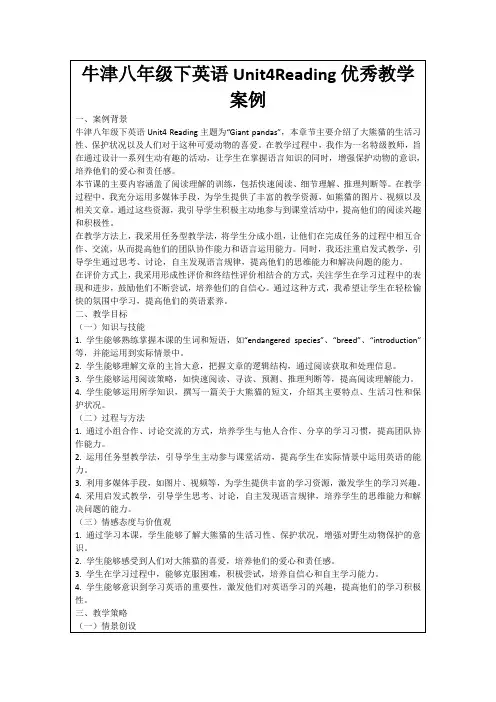
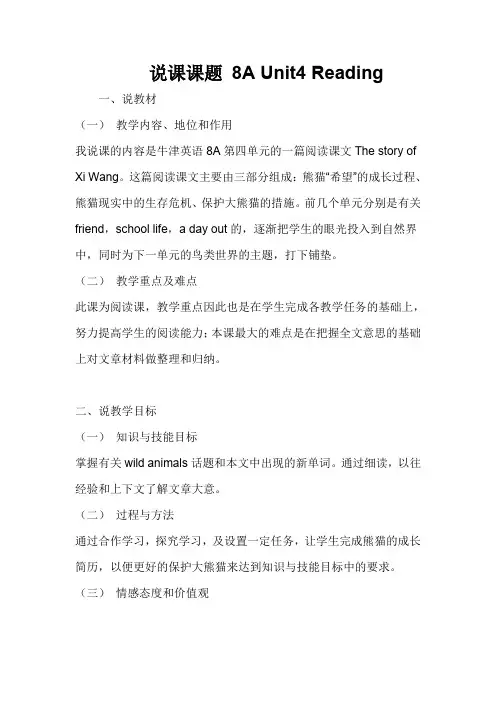
说课课题8A Unit4 Reading一、说教材(一)教学内容、地位和作用我说课的内容是牛津英语8A第四单元的一篇阅读课文The story of Xi Wang。
这篇阅读课文主要由三部分组成:熊猫“希望”的成长过程、熊猫现实中的生存危机、保护大熊猫的措施。
前几个单元分别是有关friend,school life,a day out的,逐渐把学生的眼光投入到自然界中,同时为下一单元的鸟类世界的主题,打下铺垫。
(二)教学重点及难点此课为阅读课,教学重点因此也是在学生完成各教学任务的基础上,努力提高学生的阅读能力;本课最大的难点是在把握全文意思的基础上对文章材料做整理和归纳。
二、说教学目标(一)知识与技能目标掌握有关wild animals话题和本文中出现的新单词。
通过细读,以往经验和上下文了解文章大意。
(二)过程与方法通过合作学习,探究学习,及设置一定任务,让学生完成熊猫的成长简历,以便更好的保护大熊猫来达到知识与技能目标中的要求。
(三)情感态度和价值观本课旨在培养学生热爱自然的朴素情感,激发他们保护熊猫,保护环境的热情和道德意识。
三、说教法、学法(一)任务型学习新课标开宗明义指出,新课程倡导体验,实践,合作,参与交流的学习方式和任务型学习。
(二)合作型学习是以小组学习为活动,全班为了实现同一目标共同努力的学习模式。
(三)探究型学习是以学生为主体,教师为主导,探究活动为主线的,提高学生创新意识,创新精神,发现问题和解决问题的能力。
四、说教学流程(一)教学准备PPT课件(二)教学流程Step 1. Lead-in提供一些谜语猜测动物名称such as: What animal looks like a cat and with yellow fur and black strips (tiger); What animal lives in the sea and give shows to people (dolphin),etc.依次呈现bear, kangaroo, squirrel, panda .由最后一个谜语panda导入课文。
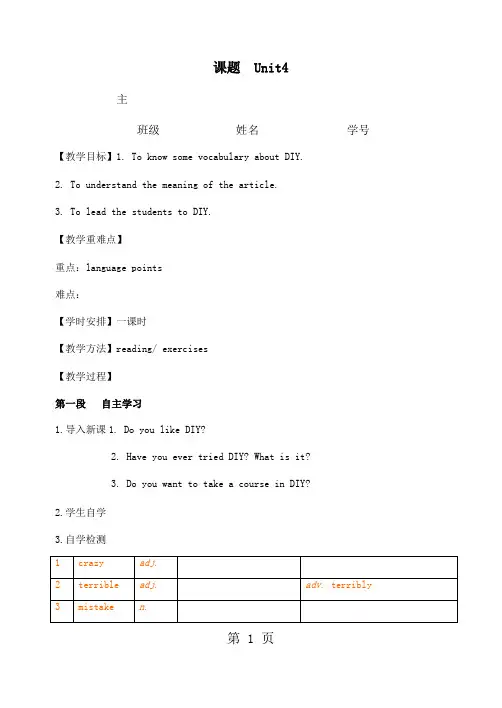
课题 Unit4主班级姓名学号【教学目标】1. To know some vocabulary about DIY.2. To understand the meaning of the article.3. To lead the students to DIY.【教学重难点】重点:language points难点:【学时安排】一课时【教学方法】reading/ exercises【教学过程】第一段自主学习1.导入新课1. Do you like DIY?2. Have you ever tried DIY? What is it?3. Do you want to take a course in DIY?2.学生自学3.自学检测第 1 页4.反馈纠错第二段问题探究5.问题探究问题(一)1. Skim the article, then answer the question: What’s the article mainly about?2. Divide the article into three parts.问题(二)1. Read the article carefully, and underline the difficult words and phrases.问题(三)Read the article again, then tell whether the statements are true or false.6.课堂质疑7.课堂小结第三段当堂检测8.课堂检测一、根据中文或首字母提示写出单词。
1. Builders spent several weeks (to fix something that is damaged,第 2 页broken)the roof and pipe.2.A large bouquet of r arrived on her desk.3.I know this idea sounds (狂热的),but it may be worth a try.4.I (建议) you to think very carefully before making any decision.5.I’m taking a (课程) in graphic design.6.Is it (已经) 5 o’clock?7.Mr.Black is ill ,so he is taking his class i .8.Only 12 people a the meeting.9.I remember (曾经)it snowed on my birthday, and I was so excited.10.There is a light hanging form the (天花板).11.He’s poor at spelling. He made a lot of spelling m in his writing.12.He is a c man. He spends all his money on stamps.13.They makes (管子) for the oil factory.14.I want to take a c in DIY.15.There are some books on the (架子).二、用所给词的适当形式填空。
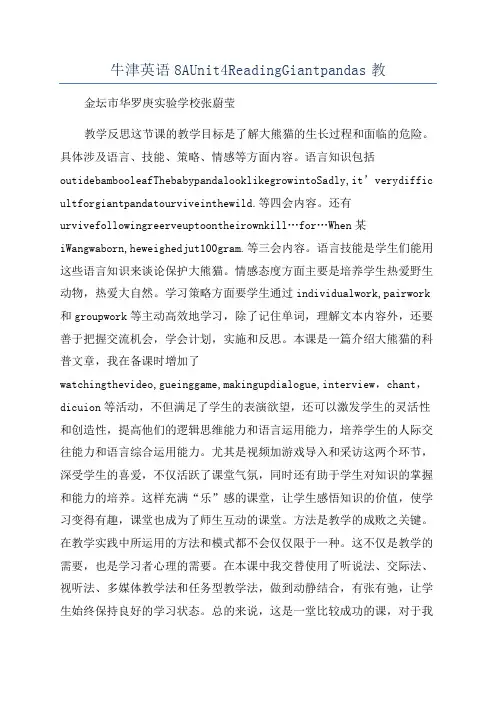
牛津英语8AUnit4ReadingGiantpandas教金坛市华罗庚实验学校张蔚莹教学反思这节课的教学目标是了解大熊猫的生长过程和面临的危险。
具体涉及语言、技能、策略、情感等方面内容。
语言知识包括outidebambooleafThebabypandalooklikegrowintoSadly,it’verydiffic ultforgiantpandatourviveinthewild.等四会内容。
还有urvivefollowingreerveuptoontheirownkill…for…When某iWangwaborn,heweighedjut100gram.等三会内容。
语言技能是学生们能用这些语言知识来谈论保护大熊猫。
情感态度方面主要是培养学生热爱野生动物,热爱大自然。
学习策略方面要学生通过individualwork,pairwork 和groupwork等主动高效地学习,除了记住单词,理解文本内容外,还要善于把握交流机会,学会计划,实施和反思。
本课是一篇介绍大熊猫的科普文章,我在备课时增加了watchingthevideo,gueinggame,makingupdialogue,interview,chant,dicuion等活动,不但满足了学生的表演欲望,还可以激发学生的灵活性和创造性,提高他们的逻辑思维能力和语言运用能力,培养学生的人际交往能力和语言综合运用能力。
尤其是视频加游戏导入和采访这两个环节,深受学生的喜爱,不仅活跃了课堂气氛,同时还有助于学生对知识的掌握和能力的培养。
这样充满“乐”感的课堂,让学生感悟知识的价值,使学习变得有趣,课堂也成为了师生互动的课堂。
方法是教学的成败之关键。
在教学实践中所运用的方法和模式都不会仅仅限于一种。
这不仅是教学的需要,也是学习者心理的需要。
在本课中我交替使用了听说法、交际法、视听法、多媒体教学法和任务型教学法,做到动静结合,有张有弛,让学生始终保持良好的学习状态。
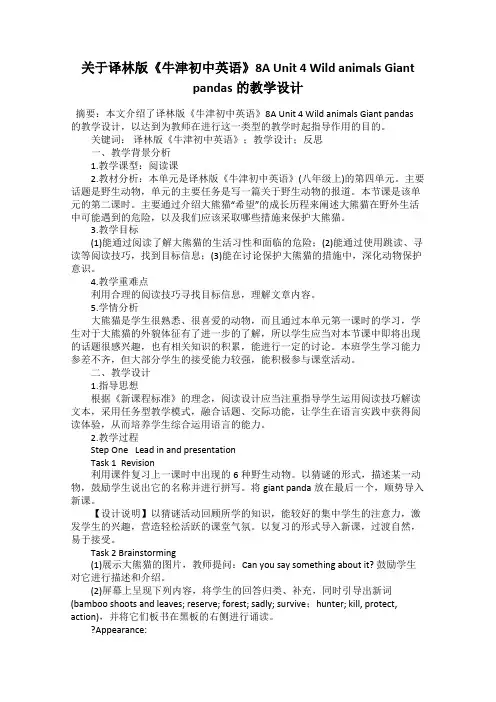
关于译林版《牛津初中英语》8A Unit 4 Wild animals Giantpandas的教学设计摘要:本文介绍了译林版《牛津初中英语》8A Unit 4 Wild animals Giant pandas 的教学设计,以达到为教师在进行这一类型的教学时起指导作用的目的。
关键词:译林版《牛津初中英语》;教学设计;反思一、教学背景分析1.教学课型:阅读课2.教材分析:本单元是译林版《牛津初中英语》(八年级上)的第四单元。
主要话题是野生动物,单元的主要任务是写一篇关于野生动物的报道。
本节课是该单元的第二课时。
主要通过介绍大熊猫“希望”的成长历程来阐述大熊猫在野外生活中可能遇到的危险,以及我们应该采取哪些措施来保护大熊猫。
3.教学目标(1)能通过阅读了解大熊猫的生活习性和面临的危险;(2)能通过使用跳读、寻读等阅读技巧,找到目标信息;(3)能在讨论保护大熊猫的措施中,深化动物保护意识。
4.教学重难点利用合理的阅读技巧寻找目标信息,理解文章内容。
5.学情分析大熊猫是学生很熟悉、很喜爱的动物,而且通过本单元第一课时的学习,学生对于大熊猫的外貌体征有了进一步的了解,所以学生应当对本节课中即将出现的话题很感兴趣,也有相关知识的积累,能进行一定的讨论。
本班学生学习能力参差不齐,但大部分学生的接受能力较强,能积极参与课堂活动。
二、教学设计1.指导思想根据《新课程标准》的理念,阅读设计应当注重指导学生运用阅读技巧解读文本,采用任务型教学模式,融合话题、交际功能,让学生在语言实践中获得阅读体验,从而培养学生综合运用语言的能力。
2.教学过程Step One Lead in and presentationTask 1 Revision利用课件复习上一课时中出现的6种野生动物。
以猜谜的形式,描述某一动物,鼓励学生说出它的名称并进行拼写。
将giant panda放在最后一个,顺势导入新课。
【设计说明】以猜谜活动回顾所学的知识,能较好的集中学生的注意力,激发学生的兴趣,营造轻松活跃的课堂气氛。
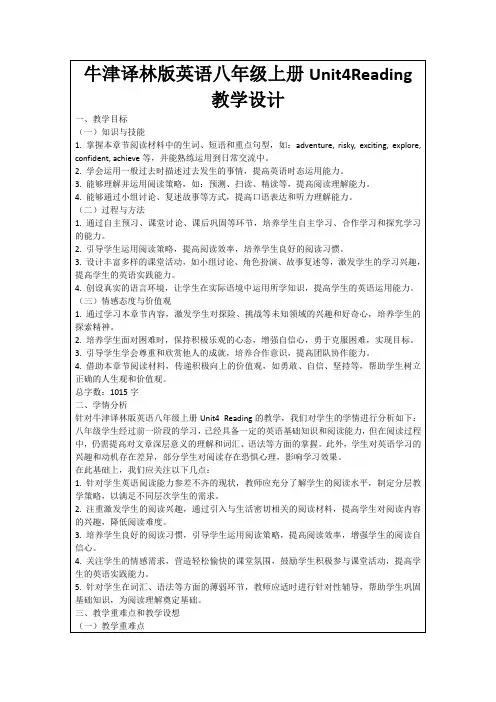
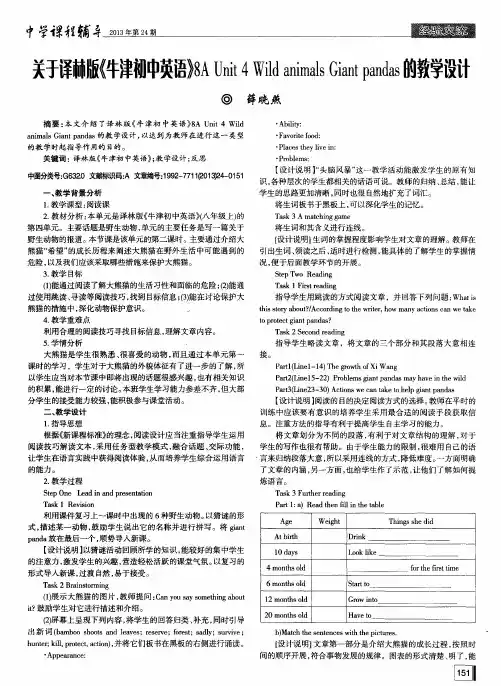
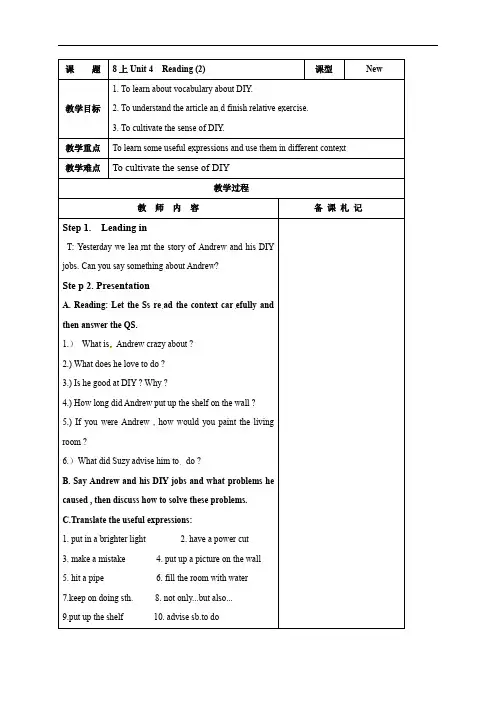
1. To learn about vocabulary about DIY.2. To understand the article an d finish relative exercise.3. To cultivate the sense of DIY.Step 1. Leading inT: Yesterday we lea rnt the story of Andrew and his DIYjobs. Can you say something about Andrew?Ste p 2. PresentationA. Reading: Let the Ss re ad the context car efully andthen answer the QS.1.)What is Andrew crazy about ?2.) What does he love to do ?3.) Is he good at DIY ? Why ?4.) How long did Andrew put up the shelf on the wall ?5.) If you were Andrew , how would you paint the livingroom ?6.)What did Suzy advise him to do ?B. Say Andrew and his DIY jobs and what problems he caused , then discuss how to solve these problems.C.Translate the useful expressions:1. put in a brighter light2. have a power cut3. make a mistake4. put up a picture on the wall5. hit a pipe6. fill the room with water7.keep on doing sth. 8. not only...but also...9.put up the shelf 10. advise sb.to do11. take a course in DI Y 12. make him angry13. attend lessonsnguage pointsAsk Ss to highlight the words、phrases、sentences they do not know. Then ask them to discuss them in pairs and try to work out the meanings from the context . At last the teacher tries to help them and expla in the language points . Step 3. practiceGet the students to read the passage together aloud again, 1)Now you know Andrew and his DIY jobs well. Can you retell the text ?2)Complete the conversation on Page 46 B4.3) Here is a DIY advertisements ,can you finish it ?Want to ( 安装电灯) . ( put in a light )Want to ( 修理坏掉的水管) . ( repair the broken pipe ) Don't know how to deal with (停电) . ( a power cut ) We ( 建议) you ( 修一门课程) in DIY . ( advise , take a course )You can ( 上课) every weekend . (atte nd lessons)Call us on 88221546 .Step 4. ActivitiesEnjoy DIY :A sk Ss to work in groups ,according to the teacher's instructions to do their DIY jobsA:Having a discussion in groupsGroup 1 : making a lovely envelopeGroup 2 : making a birthday cardGroup 3 :painting the paperB: Group presentationStep5 ExerciseFinish the relative exercise.Step 6 Homework1.To recite the text .2.Write a passage abou t how to do your DIY jobs ( such as painting a room , fixing a bicycle , making cakes, repairing c omputers )3.Preview Grammar。
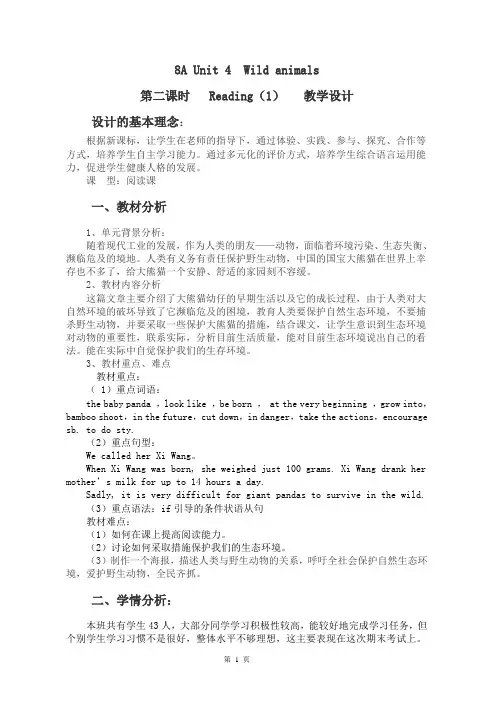
8A Unit 4 Wild animals第二课时 Reading(1)教学设计设计的基本理念:根据新课标,让学生在老师的指导下,通过体验、实践、参与、探究、合作等方式,培养学生自主学习能力。
通过多元化的评价方式,培养学生综合语言运用能力,促进学生健康人格的发展。
课型:阅读课一、教材分析1、单元背景分析:随着现代工业的发展,作为人类的朋友——动物,面临着环境污染、生态失衡、濒临危及的境地。
人类有义务有责任保护野生动物,中国的国宝大熊猫在世界上幸存也不多了,给大熊猫一个安静、舒适的家园刻不容缓。
2、教材内容分析这篇文章主要介绍了大熊猫幼仔的早期生活以及它的成长过程,由于人类对大自然环境的破坏导致了它濒临危及的困境,教育人类要保护自然生态环境,不要捕杀野生动物,并要采取一些保护大熊猫的措施,结合课文,让学生意识到生态环境对动物的重要性,联系实际,分析目前生活质量,能对目前生态环境说出自己的看法。
能在实际中自觉保护我们的生存环境。
3、教材重点、难点教材重点:( 1)重点词语:the baby panda ,look like ,be born , at the very beginning ,grow into,bamboo shoot,in the future,cut down,in danger,take the actions,encourage sb. to do sty.(2)重点句型:We called her Xi Wang。
When Xi Wang was born, she weighed just 100 grams. Xi Wang drank her mother’s milk for up to 14 hours a day.Sadly, it is very difficult for giant pandas to survive in the wild.(3)重点语法:if引导的条件状语从句教材难点:(1)如何在课上提高阅读能力。
英语牛津译林八上Unit 4:经典教案(2)(Reading 1)8A Uint 4 Wild animals--Reading(一)【Aims and demands】Knowledge objects:1.Be able to understand and use the words and phrases to describe thegiant pandas’ appearance and take actions to protect them。
2.Be able to use new words and SentencesAbility objects:1.To develop the Ss’ abilities of reading2.To train the Ss’ability of guessing the meanings of the words in thetext.3.To know the growth of Xiwang and how to protect them.Emotion objects:1.To enable the Ss to treat the giant pandas as our friends by learningmore information about them.2.To enable the Ss to realize we must try our best to protect pandas. 【TEACHING KEY AND DIFFICULT POINTS】Key points:1.New words and phrases:Outside, bamboo, leaf, sadly, action, protect, encourage, survive, the baby panda, look like, be born, grow into, at the very beginning bamboo shoot, in the future, cut down, in danger, take the actions, encourage sb. to do sth.2.Sentences:We called her XiWangWhen XiWang was born, she weighed just 100 grams.XiWang drank her mother’s milk for up to 14 hours a day.Sadly, it is very difficult for giant pandas to survive in the wild. Difficult points:1.To understand the main idea of the article.2.To learn how to take actions to protect the wild animals. 【Teaching method】 Task-based approach; Reading method【Teaching aids】 CAI, A tape recorder.【Teaching steps】Step1 Warming-upT: I’ve a wonderful song, would you like to share it with me ?T: Boys and girls, shall we begin our class now? We know every one of us has many friends and we also have many animal friends. I think animals are usually very friendly to us , we should love them and protect them. If the animals live in the wild , we can call them wild animals. Now , look at the screen ,can you tell me what they are?Step 2. Pre-readingT: Can you tell me which is your favourite wild animal?And can you tell me which is my favourite wild animal?T: Do you know why I like giant pandas best ? Because giant pandas are very lovely. They look like white mice when they were born. They look like bears when they grow up. They are friendly , too. They like eating bamboo leaves and shoots. They seldom eat meat or hurt other animals. But it’s a pity that there are not many giant pandas in the world . They’re in danger . Hunters catch them and kill them for their fur . And farmers cut down trees and forests. So they have nowhere to live. We should take actions to protect them.(let Ss read the words after the teacher) Step3. While-readingT: Here is a story of Xi Wang, a very lovely giant panda. Would you like to read it with me? Now open your books, turn to P.60. Read it quickly and answer the following questions .1) What’s the story about?2)What will happen to giant pandas if we do nothing?T: Now , listen to the tape and read after it and then answer the sixquestions on the screen . Then encourage the students to find the main ideas about this story.T: Now Let’s find the main ideas together and put them on the blackboard. T: Look at the screen . Finish the table of “The growth of Xi Wang”. Catch more details about XiWang.Step 4 Post-readingT: Now please read the passage together . Then finish the exercises on P. 61 Part B And Part C.T: Now , We’ve known the giant pandas very well , They are very lovely and we love them very much . But there are fewer and fewer pandas in the world . They’re in danger . Do you know why? Now, work in groups and find out “What problems can a giant panda meet in its life?”Then ask some able students of each group to talk in front of the class. After that,finish the Note-making 2 on the screen.T: Discuss with your partners: What other problems will the giant pandas have? What actions can we take ?And can you have a face to face interview about pandas?Step 5 SummaryTeacher makes a summary that we should take actions to protect giant pandas.Step 6. Homework1.Write an artide about “what’s the relationship between wild animals and human beings?”2.Finish the exercises of reading********************************************************一、词组翻译1看上去高兴2野生动物3和他们交谈4最喜欢5照顾你自己 6 in danger7giant panda 8 no one二、根据所给中文,拼写单词1.I enjoy the food very much, because it is very __________(可口的).2.There are many animals in the zoo, such as ________(熊)________(袋鼠)and ________(老虎).3.If you _______(死) ,no one will look after me.4.The number of the __________(野生的) foxes is becoming_______(更小的).三、你能翻译下列句子吗?1、这食物看上去美味。
《牛津初中英语》8A Unit 4 Reading教学案例
赵瑞平
【期刊名称】《文理导航(上旬)》
【年(卷),期】2016(000)007
【摘要】背景说明《牛津初中英语》8A Unit 4 Reading第一课时在整个单元中有着承上启下的作用。
在这一课时里,首先要求学生阅读有关大熊猫的文章,试着从上下文猜测词义,再学习生词;然后引导学生通读全文,找出文中的关键词和要点,教会学生从整体上把握全文;最后通过泛读、跳读、精读,培养学生的阅读能力,让学生总结文章的大意以及作者的写作意图。
此外,通过文章学习了解大熊猫的成长过程及面临的困难,
【总页数】1页(P47)
【作者】赵瑞平
【作者单位】南京市浦厂中学,江苏南京 210000
【正文语种】中文
【相关文献】
1.情境主线策略在阅读教学中的运用r——以牛津初中英语8A Unit3 A day out(Reading)为例 [J], 薛菊萍
2.提高初中英语诗歌教学的有效性探究——以《牛津初中英语》8A Unit 7 Reading的教学为例 [J], 王爱平
3.《牛津初中英语》8A Unit 4 Reading教学案例 [J], 赵瑞平;
4.牛津初中英语8B Unit 1 Past and present Reading:Times have changed教
学案例 [J], 杨德息
5.牛津初中英语8B Unit 1 Past and present Reading:Times have changed 教学案例 [J], 杨德息
因版权原因,仅展示原文概要,查看原文内容请购买。
牛津英语8A Unit4 Reading Giant pandas教案设计金坛市华罗庚实验学校张蔚莹
课前准备
根据课文内容完成下列表格。
The growth of Xi Wang
Age Weight Food
1 day 1. 4.
10 days /
4 months 2.
8 months / 5.
12 months 3.
20 months /
课堂学习根据汉语提示,写出正确的单词。
1. A baby panda is only 100 ________ (克) at birth, do you know?
2. Giant pandas love to eat _________(竹子) _________(竹笋) and leaves.
3. _________(杀死) the birds is not right.
4. Some _________(猎人) kill pandas for their ________(皮毛)
5. Maybe someday these animals will be ________(无处) to be found.
6. Can you answer the ________(以下的) questions?
7. Doing eye exercise is good for ________(保护) our eyes.
8. They are building more ________(保护区) for wild animals.
9. It’s our turn to take some ________(行动) to help the animals.
10. His parents often _________(鼓励) him to be more active in everything.
11. A bear has long and _________(厚的) hair on its body.
12. I had a call just now. After that , I _________(继续) to eat my lunch.
13. A reserve is a ________(特别的) areas for wild animals.
_________(令人难过的是), farmers cut down trees and __________(森林).
课堂检测
一、翻译词组
1.第一次走出她的家门______________
2.长成一只健康的小熊猫_____________
3.开始吃竹笋和叶子______________
4.在野外生存___________________
5.因为人们___________________
6.杀掉它取它的皮毛________________
7.砍倒树和森林___________________
8.没有生活的地方___________________
9.独立,独自___________________
10.处于危险中_______________
11.采取下列的行动保护熊猫__________
12.扩大熊猫保护区_________________
二、用适当的介词或副词填空。
1. His father died _________ he was only three years old.
2. When did you meet her ________ the first time?
3. Do you know how to survive ________ the wild?
4. ________ what do you want to kill the sheep?
5. At an early age, the boy lived _______ his own.
6. ________ four months, the baby weighed 10 kilograms.
7. Who has taken my pen_________?
8. We shouldn’t cut ________ too many trees.
课后提升
一、单选
( ) 1. If we do , soon giant pandas will die out.
A. nothing
B. everything
C. something
D. anything
( ) 2. ---How did he finish the work? ---I hear that he did it .
A. in the own
B. on the own
C. of his own
D. on his own ()3. He is in hospital and the doctor says he is ______.
A. danger
B. in danger
C. dangerous
D. a danger
()4. We will go swimming if it ______ tomorrow.
A. won’t rain
B. doesn’t rain
C. rains
D. will rain
()5. I saw such a beauty _____ in my life.
A. on time
B. in time
C. at the same time
D. for the first time
()6. Please give me a pen _____.
A. to write
B. to write on
C. to write with
D. write
()7. You shouldn’t ______ because the report is very important for me .
A. take away them
B. take it away
C. take away it
D. take them away
()8. We are going to make wild animal reserves and build more
reserves.
A. big B .bigger C. smaller D. small
()9. There are _______ giant pandas in Africa.
A. few
B. a few
C. little
D. a little
( ) 10. I think when she grows ____, she must grow ____ a beautiful woman.
A. up; up
B. up; into
C. into; into
D. into; with
二、根据中文,完成句子。
1.我第一次看到熊猫是在她十天大的时候。
I _________ saw the baby panda_________ she was only 10 ________ ________.
2.在开始时,希望每天要吃母乳达14个小时。
At the very __________, Xi Wang drank her mother’s milk _______
_______ _______
14 hours a day.
3.令人伤心的是,大熊猫在野生状态下难以生存。
________, it is very __________ for giant panda to _________ in the
_______.
4.如果狩猎者抓住一直大熊猫,他们会杀死它取它的毛皮。
It __________ catch a giant panda, they will ___________ it for its
_________.
5.如果农民砍伐树木和森林,大熊猫就没处生存。
If __________ cut _________ trees and _________, giant pandas will have _______ to live.。